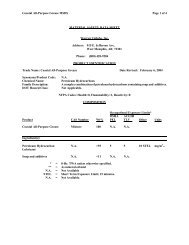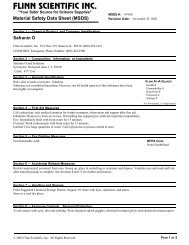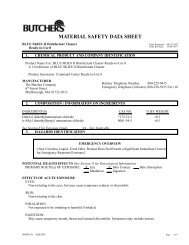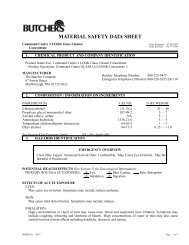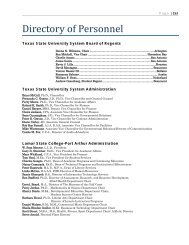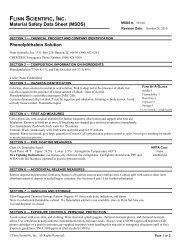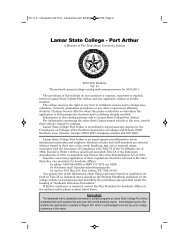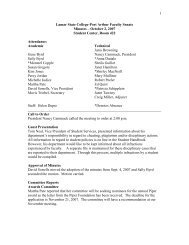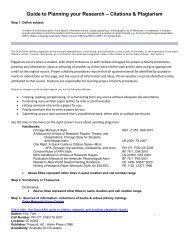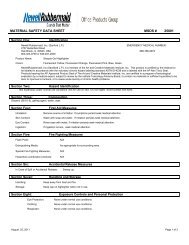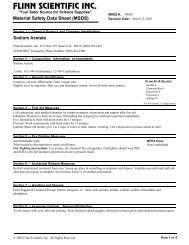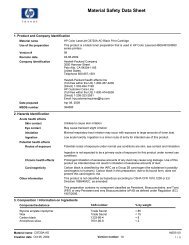Download Full Catalog - Lamar State College - Port Arthur
Download Full Catalog - Lamar State College - Port Arthur
Download Full Catalog - Lamar State College - Port Arthur
- No tags were found...
You also want an ePaper? Increase the reach of your titles
YUMPU automatically turns print PDFs into web optimized ePapers that Google loves.
Page | 39Instructional Policies/ProceduresAcademic policies and procedures are periodically reviewed and are updated. They may change during the course ofan academic year. For further policy information or updates, see the Student Handbook or go to the <strong>Lamar</strong> <strong>State</strong><strong>College</strong>-<strong>Port</strong> <strong>Arthur</strong> website (www.lamarpa.edu).Semester HourThe unit of measure for credit purposes is the semester hour. One hour of classroom lecture each week usually equalsone semester hour. For each classroom hour, two hours of study are expected. Two or more hours of laboratory workusually are equal to one classroom hour. For laboratory work that requires reports to be written outside of class, twoclock hours are usually counted as one semester hour.Academic Courses: Course NumberingThe unit of instruction for credit purposes is the course. Most courses meet three hours each week and have a creditvalue of three semester hours for one semester or six hours for two semesters.Each course has an individual alpha-numeric code (such as ENGL 1301). The alpha part indicates the subject area.Each number contains three or more figures; the first digit indicates the rank of the course: 0 denotes a developmentalcourse; 1 means that it is freshman level, and 2 is sophomore level.The second figure indicates the number of semester hours credit. The third figure (or figures) indicates the order inwhich the course normally is taken.Texas Common Course Numbering SystemCommon Course numbers assist transfer students in the transition from one institution to another. <strong>College</strong>sparticipating in the Common Course Numbering System identify “common” courses taught on their campuses. Allcourses designed for transfer adhere to this numbering system in the <strong>State</strong> of Texas.Questions about courses transferability should be referred to the appropriate department at the institution to which astudent wants to transfer. (See section on Transfer Dispute Resolution Guidelines)Technical Courses:Workforce Education Course Manual (WECM) CoursesThe rubrics assigned to WECM courses provide a common set of unique course designations. A common four-letterrubric (e.g., DFTG) identifies a cluster of skills and knowledge to be used in determining both course equivalence anddegree applicability for transfer credit on a statewide basis. This common rubric also will help students link theirportfolios of skill attainment more directly to the occupational needs of business and industry.Following the rubric is a four-digit number representing the course level, the SCH value (if applicable), and thecourse sequence. For example, in AUMT 1309, the first digit identifies the course level. For both Semester Credit Hour(SCH) and continuing education courses, the “1” denotes Introductory level; a “2” is Intermediate or Advanced level.The second digit defines the SCH value. A “3" indicates a 3 SCH, and a “4” indicates a 4 SCH course. A “O” instead ofthe “3” or “4” would denote a continuing education course that is offered for no SCH.The third and fourth digits establish the type of course and the course sequence.Core CurriculumIn accordance with the Texas Education Code, <strong>Lamar</strong> <strong>State</strong> <strong>College</strong>-<strong>Port</strong> <strong>Arthur</strong> designed a core curriculum ofacademic courses encompassing communication, mathematics, the natural sciences, social and behavioral sciences, thehumanities and visual and performing arts. A student successfully completing the entire core curriculum at <strong>Lamar</strong> <strong>State</strong><strong>College</strong>-<strong>Port</strong> <strong>Arthur</strong> may transfer that block of courses to any other state-supported institution in Texas. Thetransferring student shall receive academic credit for each of the courses transferred and may not be required to takeadditional core curriculum courses at the receiving institution.Some LSC-PA students plan to transfer to another institution before completing the core curriculum. These studentsshould follow the catalog and degree plan requirements of their receiving institutions carefully when scheduling courses.Most universities have requirements or policies regarding certain courses and the core curriculum that are unique tothat institution. Students who do not complete the core curriculum at <strong>Lamar</strong> <strong>State</strong> <strong>College</strong> - <strong>Port</strong> <strong>Arthur</strong> must satisfythe course requirements at their receiving institutions in order to receive degrees. Those requirements may varysignificantly from those of the <strong>College</strong>. Students are urged to complete the core curriculum before transferring toeliminate the possibility of being required to take additional core curriculum courses at the receiving institution.



